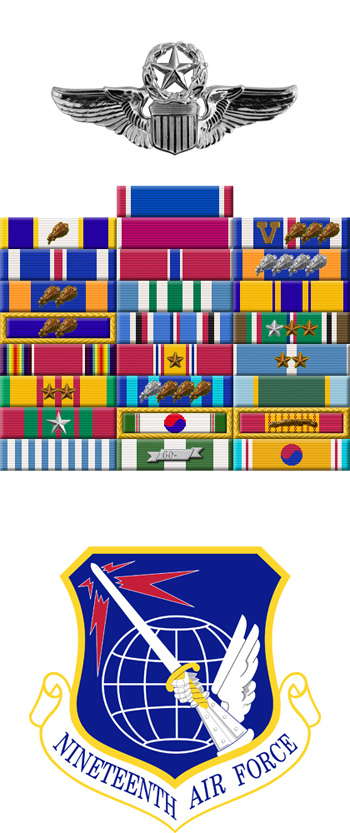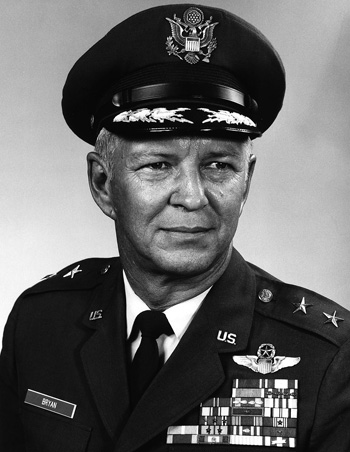
|
William E. Bryan, Jr. |
 |
|||
| Rank, Service | ||||
Major General O-8, U.S. Air Force |
||||
| Veteran of: | ||||
|
||||
| Tribute: | ||||
William Bryan was born in 1921 in Flint, Michigan. He enlisted in the Aviation Cadet Program on March 27, 1942, and was commissioned in the U.S. Army Air Forces and awarded his pilot wings on February 6, 1943. During World War II, Bryan flew P-51 Mustangs with the 504th Fighter Squadron of the 339th Fighter Group in Europe, where he was credited with shooting down 7.5 enemy aircraft in aerial combat plus one more while strafing an airfield. After the war, Bryan served at Headquarters Tactical Air Command and then as an advisor to Air National Guard fighter squadrons in Minnesota and South Dakota before being assigned as operations and training officer for an Air Force Reserve wing at Scott AFB, Illinois. In August 1950, Bryan began flying combat missions in the F-51 Mustang with the 18th Fighter Bomber Wing during the Korean War, serving in theater until April 1951. He served as a staff officer with TAC from 1951 to 1959, attending Armed Forces Staff College from January to June 1955. He served as chief of Air Offense Division at Headquarters U.S. Air Forces in Europe from August 1959 to August 1962 and then entered the National War College, graduating in July 1963. Bryan's next assignment was as commandant of the Air Force Fighter Weapons School and then Vice Commander of the 4520th Combat Crew Training Wing at Nellis AFB, Nevada, from July 1963 to January 1965. He became commander of the 4th Tactical Fighter Wing at Seymour Johnson AFB, North Carolina, in January 1965, and was then assigned as commander of the 831st Air Division at George AFB, California from January 1966 to November 1967. Gen Bryan became deputy chief of staff at the U.S. Military Assistance Command in the Republic of Vietnam in November 1967 and served until June 1969, when he was assigned as chief of staff for Headquarters Tactical Air Command at Langley AFB, Virginia. In December 1970 Gen Bryan became commander of Nineteenth Air Force at Seymour Johnson AFB, and then became deputy chief of staff for operations and intelligence at Allied Forces Central Europe in July 1972. He retired from the Air Force in this position on June 1, 1974. General Bryan wears Command Pilot Wings and accumulated over 5,000 flying hours and flew 235 combat missions in World War II and Korea. Bill Bryan died on April 6, 2008, and was buried at Arlington National Cemetery. |
||||
|
||||

